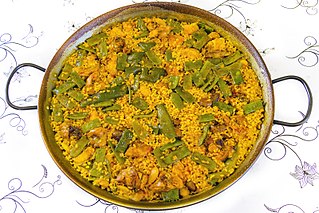
Paella is a rice dish originally from the Valencian Community. Paella is regarded as one of the community's identifying symbols. It is one of the best-known dishes in Spanish cuisine.

A sausage is a type of meat product usually made from ground meat—often pork, beef, or poultry—along with salt, spices and other flavourings. Other ingredients, such as grains or breadcrumbs, may be included as fillers or extenders.

Chorizo is a type of pork sausage originating from the Iberian Peninsula. It is made in many national and regional varieties in several countries on different continents. Some of these varieties are quite different from each other, occasionally leading to confusion or disagreements over the names and identities of the products in question.
Embutido, enchido or embotit (Catalan) is a generic term for cured ground meat products. The dictionary of the Royal Spanish Academy defines it as "intestine stuffed with minced meat, mainly pork; intestine stuffed with diverse ingredients". The term often applies to any of the many varieties of cured, dry sausages found in the cuisines of Iberia and the former Spanish and Portuguese colonies.
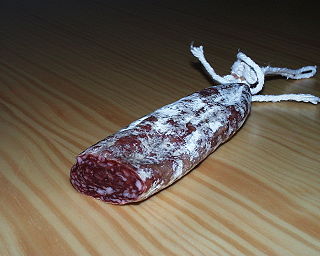
Longaniza is a Spanish sausage (embutido) similar to a chorizo and also closely associated with the Portuguese linguiça. Its defining characteristics are interpreted differently from region to region. It is popular in the cuisines of several regions of Spain, Argentina, Uruguay, Puerto Rico, Dominican Republic, El Salvador, Guatemala, Mexico and Chile. In the Philippines, it is called longganisa and has hundreds of variants with different vernacular tastes and forms due to the 144 ethno-linguistic groups of the archipelago. Longaniza essentially tracks the spread of Latin culture around the world. Longaniza derives from Lucanica, a sausage from Lucania in Southern Italy that was adopted by the Latins of Ancient Rome through military contact. From there it spread to Spain, and from Spain, centuries later, to every place in the world with modern "Latin" culture.

Arroz a la valenciana or Valencian rice is a name for a multitude of rice dishes from diverse cuisines of the world, which originate from the rice-cooking tradition of the Valencian Community, in eastern Spain.

Menudo, also known as ginamay or ginagmay, is a traditional stew from the Philippines made with pork and sliced liver in tomato sauce with carrots and potatoes. Unlike the Mexican dish of the same name, it does not use tripe, hominy, or red chili sauce.

Chorizo de Pamplona is a sausage that is typical in the cuisine of the Navarre region of Spain. It is prepared with equal parts of finely chopped beef and pork and significant amounts of a strong smoked paprika, pork fat and a natural or plastic casing which is designated to have a minimum size of forty millimeters in diameter. The red-orange coloration is due to the addition of paprika, which is abundant in Navarre. It differs from most other chorizos due to its thickness and more finely ground meat. Despite its local name, it is a very common type of sausage in delicatessens around the Spanish territory. It is also produced and sold in Pamplona, Spain.
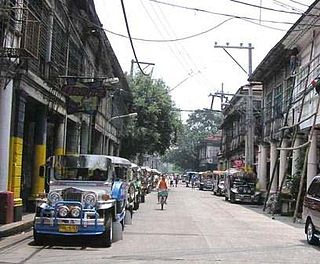
Hidalgo Street is a street located in Quiapo in the old downtown of Manila, Philippines. It runs east–west through the center of the district linking two of the district's most popular landmarks, Quiapo Church and San Sebastian Church. It is divided by Quezon Boulevard into two sections: the western section is a pedestrian zone that forms the southern boundary of Plaza Miranda running parallel to Carriedo Street, while the eastern section is a two-lane street which leads to the San Sebastian Church. Formerly known during the Spanish colonial times in sections as Calle [de] San Sebastian and Calle Crespo, respectively, it was renamed after the Filipino painter Félix Resurrección Hidalgo. It was once considered “the most beautiful street in Manila.”

Embutido, or embotido, is a Philippine meatloaf made with ground pork and stuffed with hard-boiled eggs and sliced ham or various sausages. It is traditionally wrapped in aluminum foil and steamed, though it can also be baked.

Morcón or morconito, is a Philippine braised beef roulade made with beef flank steak stuffed with hard-boiled eggs, carrots, pickled cucumber, cheese, and various sausages. It is commonly served during Christmas and other festive occasions.

Paelya or paella (Spanish), is a Philippine rice dish adapted from the Valencian paella. However, it differs significantly in its use of native glutinous rice (malagkít), giving it a soft and sticky texture, unlike the al dente texture favoured in Spanish paella. It is also characteristically topped with sliced eggs. Filipino paelya does not use saffron, but is instead coloured with atsuete (anatto), luyang diláw (turmeric), or kasubhâ (safflower).

Chorizo de Macao, sometimes called Chinese Chorizo or Longaniza Macau, is a Filipino dry pork sausage. The ingredients of Chorizo de Macao is identical to other Filipino sweet longganisas, except for its dry texture and its use of star anise, aniseed, or anise liqueur (anisado), which gives it its distinctive aroma and its name. It is commonly used in Chinese Filipino dishes like pancit Canton and siopao. It is sometimes confused with and used in place of Chinese sausage.
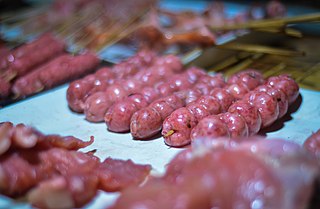
Chorizo de Cebu, also known as longganisa de Cebu, is a Filipino pork sausage originating from Cebu. It is a type of hamonada (sweet) longganisa. They are distinctively red in color due to the use of achuete seeds. Each link is also usually spherical in shape. It is made from ground lean pork, ground pork fat, salt, saltpeter, sugar, anise liqueur (anisado), paprika, black pepper, garlic, and chilis to taste in a hog casing. It can also be made without the casing. They are usually fried or grilled and eaten with white rice, puso, or garlic rice for breakfast.
Chorizo negrense, also known as chorizo de Bacólod, is a Filipino smoked pork sausage originating from Bacolod, Negros. It comes in two flavors: hamonado (sweet) and recado (garlicky). It can be prepared smoked in a casing, or prepared fresh without the casing. It is made with ground pork, vinegar, garlic, calamansi, soy sauce, black pepper, and coarse salt. Sugar is added to the hamonado version.

Philippine asado refers to two different Filipino braised meat dishes. The name originates from Spanish asado ("grilled"), a reference to the original dish it was applied to, the Chinese-Filipino version of char siu barbecues usually known as pork asado. However, the Filipino versions have evolved to be braised, not grilled. The other Filipino dishes also known as asado are asado de carajay and asado matua. Unlike the Chinese-derived version, they are savory rather than sweet.

Chicken pastel, also known as pastel de pollo, is a traditional stew or pie from the Philippines made with chicken, sausages, mushrooms, peas, carrots, potatoes, soy sauce, and various spices in a creamy sauce. The sausages used are usually dry chorizos like chorizo de Bilbao or chorizo de Macao, Vienna sausages, and/or hotdogs. It originates from the Spanish dish pastel de pollo, but differs in that Filipino chicken pastel is usually not baked into a pie, uses local Philippine ingredients, and is usually eaten with white rice. It can also be made with pork, in which case it is known as pork pastel. It is commonly served during the Christmas season.
Morisqueta tostada is a Filipino fried rice dish characterized by the addition of sausage, ham, shrimp, and spring onions. The name is Chavacano and Philippine Spanish for "toasted boiled rice." It is a very old dish adapted from Chinese fried rice with influences from Spanish cuisine by Chinese Filipino immigrants in the Spanish colonial era of the Philippines. It is sometimes differentiated as "Spanish-style fried rice". It is usually served in Chinese Filipino restaurants in major Spanish-era cities like Manila, Cebu, Zamboanga, and Iloilo. It is commonly eaten for breakfast with fried dishes like longganisa, tapa, or carne norte guisado.
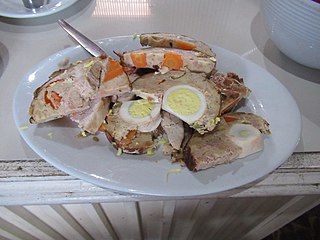
Chicken galantina, also known as chicken relleno, is a Filipino dish consisting of a steamed or oven-roasted whole chicken stuffed with ground pork (giniling), sausage, cheese, hard-boiled eggs, and various vegetables and spices. It originates from the 19th-century Spanish dish galantina de pollo, which in turn is derived from the French galantine dishes. It is popularly served during Christmas dinner in the Philippines. It is typically eaten with white rice or with bread.

















